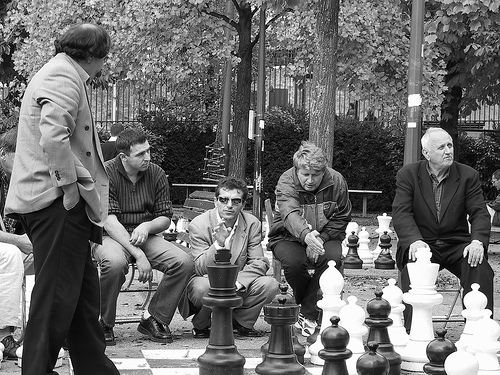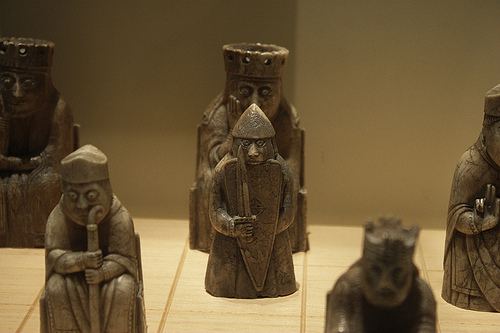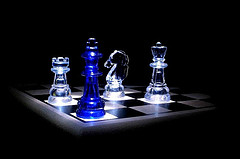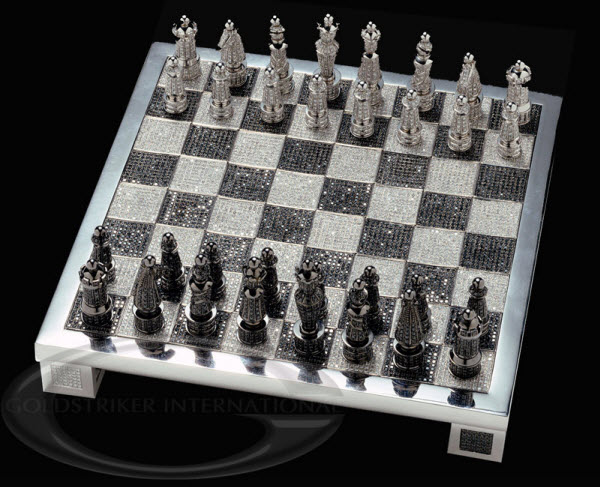Few games have the breadth of play that Chess enjoys. Chess as we know it has been with western civilization since the 10th century CE, having adapted from Indian and Persian games over a few centuries before that. While the precise rules have evolved over the years, the game at its root remains the same. Literature about Chess fills volumes, with some of the earliest scholarship on the theory of playing Chess starting in the 15th century. Around the globe, Chess is played competitively by people of all ages, and many international Chess champions are widely recognized names. There are films about people playing Chess, and it suffers very little of the stigma commonly associated with board games. Still, it is a foundational game that has had an indelible impact on the hobby.
Game designer Daniel Solis lists Chess as one of the archetypal, 1000 year games that we have. It stands alongside games such as Tag, Soccer, Go, and other folk games as being nearly universally known.
Chess developed under conditions extremely different from modern game design, with little to no thought given towards any form of commercial model. According to Solis, for a game to last the 1000 years that Chess has, it has to be simple enough to teach and remember by word of mouth, yet complex enough to be rewarding when you complete it. Game pieces would also need to be accessible to all members of a society, while still being scalable in value.
Chess succeeds in each of these criteria. Its rules are easily understood once they are learned, and aside from a few small specific circumstances, are fairly universal. Each move of the game increases its complexity, with strategic options opening up as the game progresses. Victory, once achieved, is a result of insight and planning, and not happenstance. All one needs to play it are a square board set with 64 spaces in an eight by eight grid, and thirty two pieces which can be differentiated. The game board can be drawn in dirt with stones used for the pieces, or can be found made from precious gemstones and hand carved marble. Chess is also scalable, able to be played as small as pieces can be manipulated or as large as can feasibly be moved.
A Battlefield Waltz
At its root, Chess is a highly stylized game of moves and counter moves where both sides have access to the exact same resources. Each side starts with eight pawns, two rooks, two knights, two bishops, a queen and a king. Players take turns moving a single piece according to its movement rules. Pieces capture and remove opposing pieces from the board when they can move into the same space. The goal of the game is to place the opponent’s king into a threatening position with no ability to prevent his capture. Traditionally, the sides are made of white pieces and black pieces, and the player with the white pieces always moves first.
The rules of Chess do not vary at all during the game, though there are a number of exceptions to the main mechanic of the game pieces. Some examples include:
- A player may move their king and their king’s rook as one specific move if neither has yet moved this game.
- Pawns can advance forward twice if it is their first move.
- No piece can move in a way which allows the king to be threatened.
- A tie, called a stalemate, occurs from a variety of circumstances and a checkmate (victory), is impossible.
- Knights ignore intervening pieces when moving.
Such exceptions are the only difficulty in learning the rules of Chess, but much like other long-lasting games, the rules are only the beginning of the learning curve the game possesses. With no random element beyond who goes first, skill dominates the play of Chess, emphasizing a player’s ability to read their opponent’s strategy and counteract it many moves ahead.
The width of Chess’s appeal and knowledge is undeniable. Its permutations and study are accepted as legitimate pursuits, and Chess players are often held as separate from other gamers. Chess, while being undeniably a board game, holds a status that seems to set itself apart from the hobby. In many ways Chess is considered a hobby entirely to itself, with its own culture, traditions, lexicon and others. It is the game we designed computers specifically to play it, and we held it up as a great achievement when it defeated a Grand Master. Ultimately, however, Chess is still a game and it must be held up to the single most important standard of games: Is Chess fun to play?

Every move you make matters. Luckily you’ll have friends to help tell you why what you just did was wrong.
The Anti-Party Game
The answer ultimately falls along the lines of what you look for as a player. Chess can be an early litmus test for the style of games that will appeal to you, as it is often one of the first serious board games one encounters. Chess’s lack of large groups and focus on competitive play will turn off many Socializers from enjoying it, simple as that. Several other gamer types may be drawn to the game’s periphery more than the game itself. Chess is too directly confrontational for many Architect, and the game’s progression is towards limiting options and fewer pieces – the opposite of an Architect’s preferences – likely may make playing it out more of a chore. The quality of the physical Chess set may be the ultimate determiner for an Immersionist, as the game itself is as dry and abstract as it comes. It’s likely a quality Chess set with intricate pieces and fine workmanship will appeal to them as more of a show piece than an actual game.
Daredevils will quickly latch onto Chess played under a time clock, with an emphasis on fast thinking and speedy action. Forcing your opponent to run their clock through unpredictable strategies allows them to use their individual styles to their advantage. Without the clock, however, they lose that component, and likely their interest in it as well.
Similarly, Speed Chess also appeals to the Striker, as the path to victory comes from removing your opponent’s pieces from the board. Every capture reduces your opponent’s options and means of victory. They must be careful, however, for trading pieces can quickly get out of hand, and player must make sure they are not leaving themselves tactically open for a counterstrike while attacking.
In reality, only one Archetype is truly drawn to it. It is the Tactician who finds in Chess the best possible game, and it is Chess that many Tacticians remember as one of their first games. Chess is a game of pure mental tactics, a game where two minds battle against one another in a limited field with limited options. Chess appeals to the strategist in all board gamers, as its rules are simple and its play is elegant. Victory, when it happens, is clear and undeniable. Even a loss allows for the Tactician to learn from the experience, and be better prepared for it in the future. Observers should beware, however, as the natural tendency of the Tactician to take their time with their turn can grow to truly amazing proportions in a challenging game of Chess.
In many ways, Chess goes beyond the realm of a classic game – something bound to happen to a game around for a millennium or more. Much like Backgammon, Checkers or Go, Chess’s lifespan is exponentially greater than even often-derided cantankerous old centurion, Monopoly. It is a game that encapsulates many aspects of gaming that humans innately enjoy, while at the same time it eschews attempts to easily compare it to more modern games. (It’s usually the other way around.) It is at once simple and profoundly complicated, easy and yet highly challenging. Part of its draw is its legacy: it’s actually unlikely that Chess would catch on the way it did if it were created today. Yet it continues to find new audiences even in an era of refined game design and a plethora of gaming options, providing a clear sign that Chess lasted this long for a reason, and it is not going away anytime soon.
Photo Credits: Chess cover by dakluza; Lewis Chessmen by Marc Kjerland; Checkmate by Judhi Prasetyo; Outdoor Chess by Jean-Pierre Martineau; Diamond Chess set by Luxuo.



